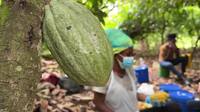Swiss Platform for Sustainable Cocoa
Switzerland is a land of chocolate (lovers). The basic ingredient for this fine product is provided by cocoa farmers in developing countries. A good six million farmers worldwide earn their livelihood by growing cocoa beans, producing around four million tonnes annually. Around three per cent of this is turned into Swiss chocolate.
However, the average per capita income of female cocoa farmers in developing countries is below the poverty line of 2.15 dollars a day. The price of cocoa on the world market is high, but the money does not reach the farmers. Cocoa cultivation is also partly responsible for deforestation. When farmers earn too little, they are often forced to cultivate intensively and clear virgin forest.
More social and ecological sustainability is therefore needed. That is the aim of the Swiss Platform for Sustainable Cocoa. It brings together around a hundred members from Swiss companies, civil society and the federal government, represented by SECO, who want to tackle the problems together.
The platform develops innovative solutions for greater sustainability throughout the cocoa value chain: plant cultivation, trading in beans, and the processing and sale of products should all have a positive social, ecological and economic impact in cocoa-producing countries. The primary goal is to improve the income of female cocoa farmers, better integrate them into value chains, and so improve their livelihoods.
The share of Swiss imports from sustainable production has risen from just under 60% in 2018 to 82% in 2023. In the long term, Switzerland only wants to import cocoa that has been produced sustainably.
Cocoa beans can be used for more than just chocolate
Grace and her mother work on a cocoa farm in south-east Ghana. They are among the more than 3,000 farmers who work for the Ghanaian-Zurich company Koa – a member of the Swiss Platform for Sustainable Cocoa.
Grace not only sells the cocoa beans, but also the pulp, which is used to produce a fruit juice in Ghana itself. This is exported and also served in restaurants and bars in Switzerland (interview excerpt Grace).
Grace
Cocoa farmer
For the families in Ghana, this provides additional income because more is extracted from the cocoa plant than just the beans and a larger part of the added value is generated in Ghana (interview excerpt Grace).
How San Martín is sustainably redesigning cocoa cultivation
Cocoa has been grown in San Martín, Peru, for many years. Today, this is the most important cocoa-producing region in the country. The Sustainable Cocoa Sourcing Landscapes 2.0 project helps farmers to manage their plantations sustainably, without deforestation. The project promotes climate-resilient farming practices that also improve the livelihoods of local communities.
The project brings together a range of partners, including producers, cooperatives, trade organisations and exporters, to discuss measures aimed at continuously improving cocoa production in Peru.
For example, a digital solution has been developed to track raw materials throughout the supply chain. This ensures compliance with sustainable practices, such as the EU Regulation on deforestation-free products.
Growing climate-resilient cocoa
Do you like pralines? It is quite possible that the chocolate comes from cocoa beans from the Sambirano Valley in the north-west of Madagascar: This region is known to have some of the best cocoa beans in the world.
Cocoa is an important source of income for the farmers in the Sambirano Valley. But climate change is presenting them with new challenges: Higher temperatures, longer periods of drought and more irregular rainfall lead to soil erosion and more difficult harvests.
The Swiss Platform for Sustainable Cocoa is working with Helvetas and Swiss chocolate companies to restore the damaged ecosystems in the Sambirano Valley. Deforested areas are being replanted, and cocoa farmers are being familiarised with practices that protect the ecosystem. The project is also committed to ensuring that farmers own more land themselves so they are incentivised to invest more in forestry and reforestation.
Scroll down to continue
Swipe to continue
Swipe to continue























 Swiss Platform for Sustainable Cocoa
Swiss Platform for Sustainable Cocoa














